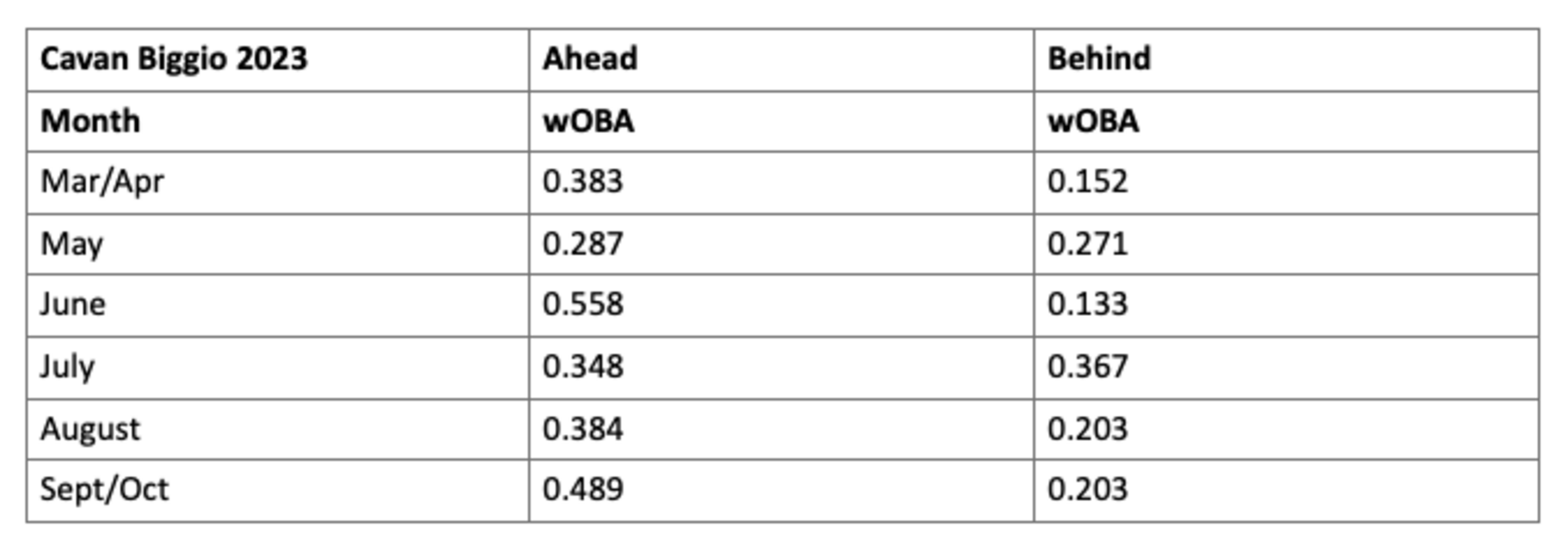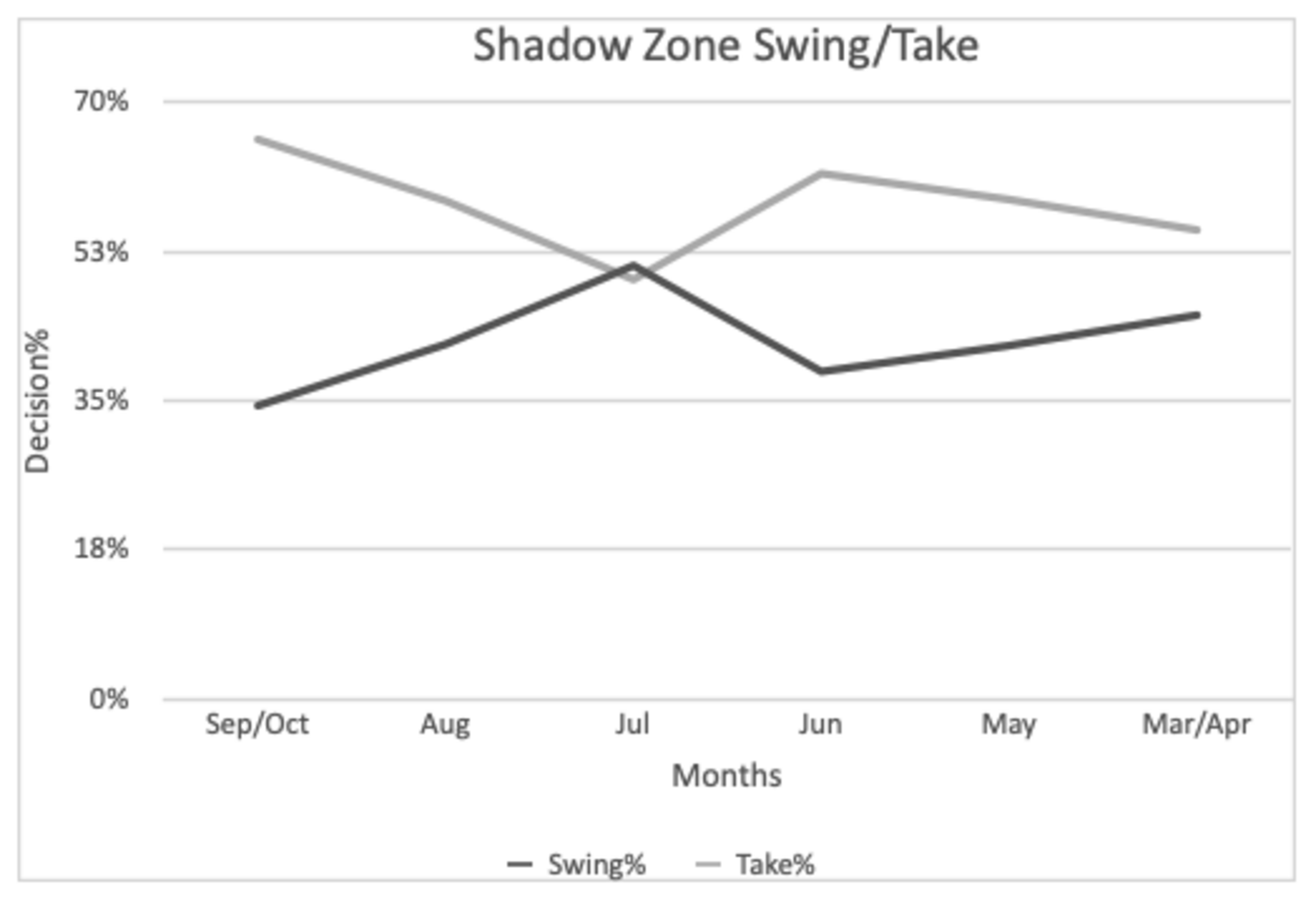
With only a few weeks until spring training, I considered infield options that the Toronto Blue Jays have for third base. As it stands, Matt Chapman is no longer with the team and the Blue Jays have a handful of options who can play the hot corner.
Many names will be thrown at the position and one of them is Cavan Biggio. While it’s easy to point to disappointing overall numbers, in my opinion, he had a much better offensive season in 2023 than some give him credit for, especially in September when he was an everyday player. With more consistent playing time, my question is, can Biggio unlock something offensively like we saw last September but with more consistency?
I looked at his swing/take patterns in distinct parts of the strike zone to find out. I’ll go month by month describing the context of his usage and document why he got hot, and why he was cold. I wondered if anything changed in Biggio’s approach throughout the season, really delving into his swing/take decisions, if he was getting ahead/behind counts, and if there were some changes, he made to increase his offensive output. Inversely it was a tough start to the year for him, which I also want to know more about.
While 2023 marked the season with the most at-bats since 2019 for Biggio, it was never a straight and narrow road for the utility man. While on the surface, his first and second-half splits were awful and then good, that’s only because of a poor month of April, and he always had a wRC+ above 100 for every other month. Biggio had a lot of good at-bats because he identified pitches well indicated by a great chase and walk rate. This is important to go deep into counts, which affect wOBA drastically.
April was unkind to Biggio, and it reflected in his appearance in a season-low 56 percent of games during the month. His longest stretch of consistent playing time was from the 9th to the 13th, as he appeared in each game, however, he did not do anything offensively, producing a strikeout percentage of of 54.5 while his exit velocity was around 82 mph.
Here is a look at Biggio’s swing/take percentages for the year, starting with September and October on the left and working backward to April and March.

So, if April was such a bad month for Biggio, what was a common theme? For one, he was behind the count more than he was ahead. He had by far the lowest exit velocity of the year (79.6mph! per baseball savant), and his OPS was just over .400. Usually, being behind in the count is much more predictable to have a worse wOBA versus being ahead.

Checking the quality of his plate appearances should be important in analyzing these hot and cold streaks. There are other factors we should consider, such as the heart, shadow, chase, and waste portions of the strike zone individually. For this article, I will restrict this to the first two, as that’s where most pitches thrown were.
To understand the importance of the heart and shadow part of the zone check out this graph showing the number of pitches thrown to him in both parts. The Shadow zone is represented in Blue, whilst the heart is in orange.

In April, he did not have an abnormal amount of shadow zone pitches thrown at him. However, he could not do damage within the heart of the plate. I think that’s key, especially for the number of fastballs he sees.
Now this is all in the lens of getting ahead of counts more often for an increase in wOBA. Swinging in the shadow zone is not good for wOBA. Therefore, tracking his swing/take in the shadow zone is important.

Biggio’s season turned around at the mid-way point of May. He appeared in only five games in 15 days yet, he ended up appearing in 64 percent of the games in the entire month! It’s a difference of two halves in May, especially for wRC+ (43/173, after May 16th). Hand credit to the player for fighting over a month and a half to make it possible.
This could be attributed to taking much more during the second part in the shadow zone and he was making more consistent contact outside. Including lowering his swinging strike rate down over half what it was at the beginning of the month. His outside swing percentage went down whilst his contact rate climbed indicating he was getting the bat on the ball more. This can also be shown in my findings, where his general whiff rate decreased by around 11 percent within the month. Biggio would finish the month with an OPS of 0.833, the best of his season and a dramatic turnaround from April.
His wOBA within the heart of the plate also jumped significantly within the month (0.425 – 0.658). Indicating the importance of those pitches over the plate and how important it is to stay hot.

In June he appeared in 63 percent of available games, including in six straight games between the 11th and the 17th. June also marked the first time in the season where he had more pitches ahead of the count than behind it for his best wOBA under these circumstances. He had a wRC+ of 114 while walking over 10 percent of the time. He also had one of the lowest swing rates in the shadow zone during the entire season.
What’s more important is his ability to slug over the heart of the zone. Like May, he had a SLG over .900 however, the launch speed of these balls was an elite 96mph. More impressive, he did not whiff on a single ball. He also had to deal with the most pitches in the shadow zone that month, wisely taking 38 percent of those pitches. Taking those undoubtedly led him to a better position in counts as it was the first month where he had more pitches ahead than behind.
This led him to a career highlight — an eighth-inning go-ahead bomb against the Minnesota Twins.
With a better plan at the plate (attack pitches within the strike zone/layoff edge pitches), Biggio positioned himself for one of his best offensive months at the plate. While he did have a low BABIP, his improved exit velocity (92 mph) was an encouraging sign getting to the ball easier. Biggio was officially in his bag.
As you can see in the shadow zone swing/take graph from earlier, Biggio started swinging much more in the shadow zone. On the surface, it was not such a problem. Since he produced close to the same wOBA being ahead vs behind, he also had a similar usage rate to June. However, he had fewer Plate Appearances (13), and a dramatic reduction in exit velocity, possibly because of his aggressiveness with 50/50 pitches (58 percent O-Contact).
Although his whiff percentage in the shadow zone was roughly the same, he managed to whiff on a season-high 17 percent of pitches inside the zone. This is disappointing, although it should be expected to increase, given that he whiffed on 0 pitches there last month. This led to a decrease in exit velocity by a factor of 14 mph within the heart area, a season-low 4 hits all month drastically reducing his quality balls in play.
This led to a major imbalance between being ahead versus behind, in fact, it was the largest discrepancy of the year. While there was not a large difference in wOBA, I think that’s more of having a high BABIP within the shadow zone (.500), while swinging heavily in the shadow zone, and not doing enough damage inside the heart of the plate.
Biggio saw a dip in productivity in July, but it was not going to stop him from having a great August. He had a wRC+ over 130, on even less PA than the previous month. He appeared in 67 percent of games while having one of the crazier BABIPs I’ve seen, .533 (small sample size, but still). In July, he struggled with getting ahead in counts, but in August it was much more neutral, helping his cause offensively. Perhaps this was because he was taking an additional nine percent of shadow zone pitches, reducing that 50/50 split from last month. That’s a good thing since he was nowhere close to production behind the count as he was in July.
A reduction in whiffs over the heart of the plate by a factor of 11 percent compared to July, also helped him get the bat on the ball. He was also less aggressive here than in previous months, reducing his swing by nine percent in the heart. This is not a good idea for someone like Biggio, since a lot of the pitches he sees here are fastballs, and it’s much more in line with his awful April. Considering that in May, he was swinging at 80 percent of pitches within the heart zone, it seems unreasonable for it to be that low (68 percent).
Biggio appeared in 9 straight games between August 10th and 20th. He produced magnificently with a season-high wRC+134 and an OPS of .762, all the while walking 15 percent of the time. He batted anywhere from 9th to 4th, playing 4 different positions, including starts in RF. That’s the appeal Biggio can bring, some lightning-in-the-bottle offensive production with defensive versatility.
September was Biggio’s best month by a long shot. For one, Biggio appeared in a season-high 93 percent of games making him an everyday player down the stretch. He nearly had 100 PA and was squarely ahead in most counts, resulting in a wOBA of nearly .500 under these circumstances. He was taking a season-high number of pitches (around 65 percent) in addition to taking around the same percentage of shadow pitches. Remarkably, he whiffed on only 18 percent of pitches from my calculation (all areas). Most interestingly, he was not doing all that much damage within the heart of the zone, with a wOBA of 0.282.
What’s crazy about September is his wOBA from the shadow zone. While trying to do damage on those pitches is not a good idea, he had a wOBA of 0.362 by far the highest of the season. I don’t think this is repeatable for 2024, however, at least he has shown the ability with consistent playing time he is not completely lost there.
Biggio did this by spraying the ball all over the field with having pretty even splits between Pull percentage, Cent percentage, and Opp percentage with an exit velocity consistently in the high 80s to low 90s mph. He had a good line drive rate while avoiding ground balls. His wRC+ of 123 was also excellent although it was not for much power, but he managed 5 doubles with a home run. He had an amazing BB percentage (18.4 percent), paired with an amazing K percentage of 19 percent. He was thrown mainly fastballs which is consistent with the whole year.
While Cavan did well in his whiff percentage, in the shadow zone it was still much higher than his general whiff percentage for the month. However, with his low production within the heart of the zone, it’s difficult to gauge how sustainable this is in the long run. However, with more consistent playing time, Biggio was dealing. There’s no question of that.
More must-reads:
- Cardinals' Willson Contreras suffers broken arm after being hit by swing
- Watch: Phillies' Bryce Harper stays hot with another grand slam
- The 'MLB Rookies of the Year' quiz
Breaking News
Customize Your Newsletter
 +
+
Get the latest news and rumors, customized to your favorite sports and teams. Emailed daily. Always free!

